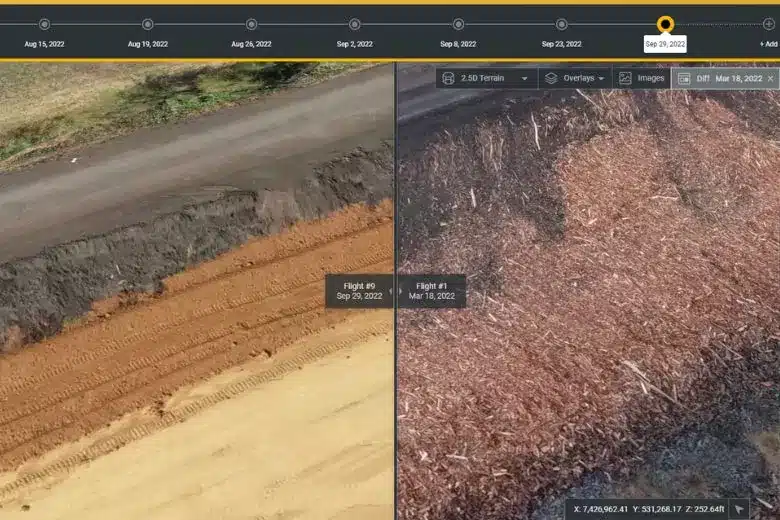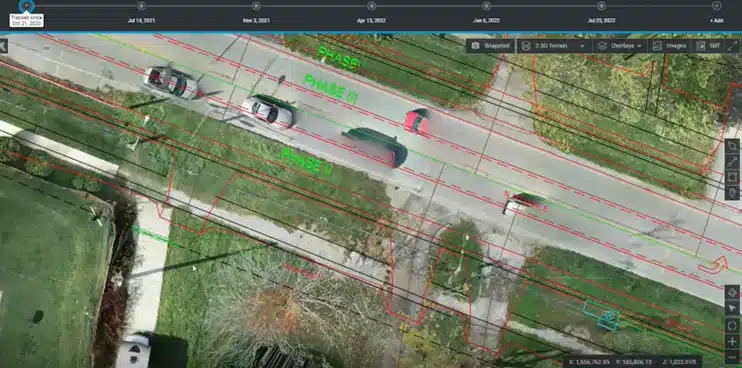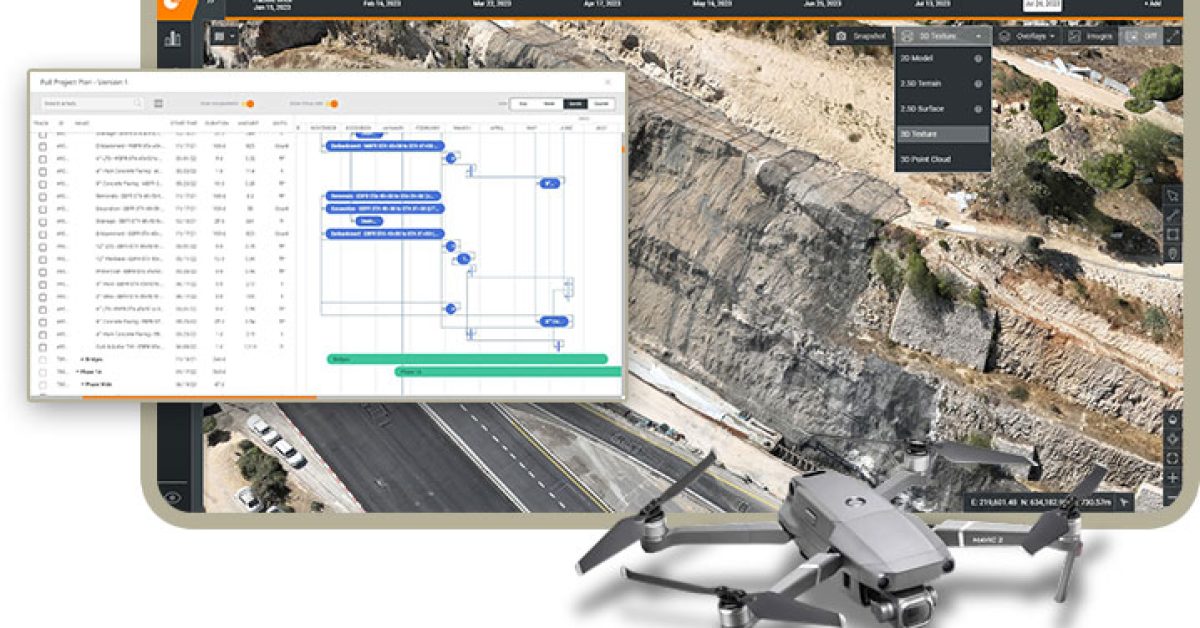High level of complexity in heavy civil and infrastructure construction projects
Did you know that ineffective communication between relevant parties on a construction project constitutes 56% of the overall risk?
Especially in heavy civil and infrastructure constructionInfrastructure construction refers to the process of designing, planning, and building physical structures and facilitie… More, stakeholders are dealing with an extremely high level of complexity. There are usually multiple teams working on numerous concurrent projects, often heavily reliant on manual data collection and processing, and without complete visibility or site data to hand.
What does miscommunication mean for construction projects? And how can photogrammetryPhotogrammetry is the science of obtaining accurate measurements and three-dimensional information from photographs. It … More and drone mapping software with advanced data analytics and digital constructionDigital construction, also known as construction technology or construction 4.0, refers to the use of digital tools and … More management make all the difference?
The impact of miscommunication in construction
On day one of any project, everyone is committed to the same goal. But giving all stakeholders access to every plan from overall design through to infrastructure, electricity, water, drainage and more is usually a lot more challenging. And, even the best made plans often go off track. Subcontractors are unavailable, materials are not ordered on time, procurement delays occur, payment disputes impact the schedule… the list goes on.
Behind the scenes, ask any single stakeholder why a project isn’t running to schedule, and they will each have their own perspective. Without a single source of truth, conflict and mistrust can rise up between teams. Especially when you’re working with a remotely distributed business model, it can be tough to bridge the gap between onsite employees and remote office staff.
There are an infinite number of moving parts when it comes to construction, leading to problems such as:
- Bottlenecks: With staff making decisions based on instinct or out-of-date and subjective Excel spreadsheets, they can’t help but get it wrong at least some of the time. That means projects are delayed to wait for subcontractors, or laborers lose days worth of pay while a project is on pause.
- Friction: Without data to hand, everything becomes a matter of who to trust, adding tension to relationships between owners, managers, and contractors. Take payments for example. Contractors minimize risk by paying at the lower end of the scale as they can’t be 100% sure what work has been done. Subcontractors feel the need to overclaim to close the gap.
- Rework: On a busy construction site, dealing with changes to design is a common problem, and often occurs once work has already been completed. How much rework has been involved? Who should be reimbursed? Without accurate records of project progress and visuals to match, it’s tough to reach a mutual agreement.
- Cost: As each stage of a construction project suffers, poor communication can’t help but impact the bottom line. Misunderstandings, slow turnaround times, errors, and the simple impact of wasted time. Depending on the type of project, each delay has the added risk of opening the potential for litigation, claims or penalties.
The challenges of communication and collaboration across teams have a single solution – a clear and objective understanding of project status, agreed on by all parties involved. While owners, contractors and subcontractors have complex relationships to contend with, if all parties have a single source of truth – misalignment is eliminated, productivity increases, and revenues grow, making everyone happy.
From manual to automated: the impact of a digital construction platform
The ability to obtain granular visibility from the site, and details about project process, and then to share this crucial information with other stakeholders, no matter where they are located, minimizes the potential for mistakes, and paves the way for data-driven decision making. Instead of relying on disparate teams and their subjective opinions, a data analytics and construction management solution automatically gathers data into a single dashboard, ensuring everything teams need is up-to-date and in one place.
Pihl Excavating is using DatuBIM, a digital construction platformDigital construction platforms are used to streamline and optimize construction processes using digital technology. They… More proven to improve collaboration and visibility on a project at the Hampton Lumber Mill, and has so far seen a 70% increase in collaboration. Drone images, which are acquired on a regular basis, are uploaded to the cloud, and survey-grade models and maps are generated automatically. Reports are then used in all status meetings, with relevant information sent directly to project managers and estimators as the project progresses.
As the platform includes photo documentation and progress tracking, anyone can get an accurate view of the status of the project, rather than relying on subjective information. Simply put, instead of trusting their gut, stakeholders can frequently log in and see exactly how far along specific teams or tasks have progressed, and then use this information to make better decisions for their own workload. This has also enabled Pihl Excavating to cut down on onsite time by at least 50%.

Increased transparency also reduces miscommunications, allowing stakeholders to build trust and form closer relationships and loyalty. ATS construction is seeing this in action on a recent urban road project for the local government. The company knew there would be challenges aligning different teams, as design work had already been completed previously, and plans were likely to deviate from real-world conditions. Images from drones, as well as mapping and analytics from the DatuBIM platform enable continuous end-to-end digital project documentation, allowing the company to manage change requests and settle claims quickly and easily. All of the data can be accessed from the office or even from home, minimizing field visits for office workers, while improving communication and visibility.
Real-time communication means less chance of rework. For example, ATS has found that when plans conflict with actual site constraints, this is immediately documented and reported, so that the design can be adapted before the work is completed.

Improve communication and collaboration with DatuBIM
Construction may have traditionally been a lagging adopter for modern technologies, but this is no longer the case. 96% of those in the construction industry believe that technology can improve productivity.
By adopting cloud-based data analytics and construction management platforms like DatuBIM, organizations can say goodbye to subjective, manual processes, and add real-time collaboration and communication to their toolbelt.
This supports all stakeholders, from improving communication between those in the field and personnel in-office, to adding visibility via in-depth reports for project managers and superiors. Individual teams can get more accurate information about project processes, and share this insight between teams too – so that everyone is always aligned, at all times. All stakeholders across a whole project, including owners, general contractors and a wide range of subcontractors have a single view.
In short, with DatuBIM, the entire supply chain can start operating as a well-oiled machine, ensuring everyone involved in any project is entirely on the same page. Visualize digital twins of your real-world construction site from various dates over time, continuously monitor project progress on the cloud and compare with design or construction plans, and support effective and collaborative decision making across all of your stakeholders.
“The biggest benefit of using Datumate’s platform is that it’s a relationship builder. When all stakeholders have access to the full picture, we can alert the owner before things are done. The owner is definitely seeing major benefits from this as they are saving on change orders and delay costs.”
Dylan Murphy, Project Manager at ATS Construction



